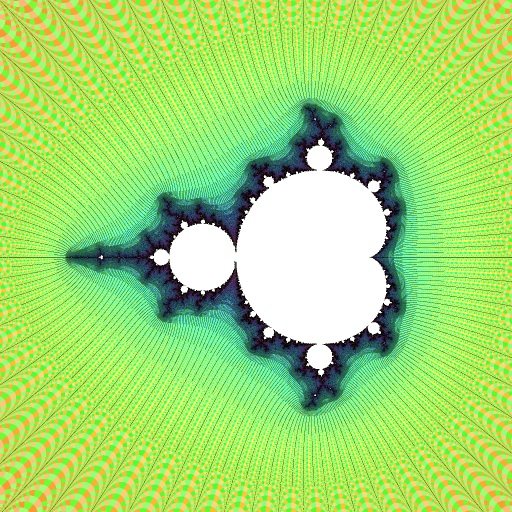R2t Series
Robert P. Munafo, 2023 Mar 23.
The R2t Series is a series of mu-molecules on the real axis beginning with R2F(1/2B1)S and proceeding west towards the tip.
Each island in the series has a period one greater than the previous member of the series.
The series contains the smallest island of any given period. Here is a table of the first few:
| Period | R2 name | size rank | Area | Location (center and size) |
| 3 | R2F(1/2B1)S | 1st | 5.1023e-04 | -1.759672 + 0i @ 0.067687 |
| 4 | R2F(1/2B1)FS[2]S | 37th | 1.4635e-06 | -1.941076 + 0i @ 0.003627 |
| 5 | R2F(1/2B1)FS[2][2]S | ≅ 2177th | 5.0830e-09 | -1.985441 + 0i @ 0.000214 |
| 6 | R2F(1/2B1)FS[2]FS[2]FS[2]S | ? | ≅ 1.9e-11 | -1.99637834 + 0i @ 0.000013 |
| 7 | R2F(1/2B1){FS[2]}x4S | ? | ≅ 7.4e-14 | -1.9990964107298 + 0i @ 8.1e-7 |
The Period-4 island
There are three islands with period 4, the other two being R2F(1/3B1)S and R2F(2/3B1)S.
fs(2)s.jpg) the leftmost period-4 island | '-, ' - '-, -, c - .- '-,, "_ ', .- / _,' '-, '\ -, '.a__-.~ . -/` '-, '~, '-, -'%@bdd, .-~ ./-` '-, -, _ '-,L.a@F@F_-' _ .,' '. \ '-, ,\.\ -"@F^`^Y@~-/`c:~ ., `, \ -, .'ebmm_)b_@b_ ,d@ddmcL\@r/-' , '", : ', . '. :@T@^""` '^*^^@F.^ __,--^ `-, -, , .__.:.-a c'\'v@*" ''@,a_' `-, -, `.@@mdLd@)L:/)@^ ^%F'^____ '\ v . -,'/\m@^"^'^^"b@" $)m ^..\.L:.\.~d'@d@F 'Y .:F`-^` -------vrY@(@(Y@@C,_; : '"b"--------- -' `'''.-'/ \F*Y@e .d '@CL-- ./' ' .'.\-'T@La_,_amFY; .$@______ _/' .- _,-v@F(`Y@*F'd'@m, _$@c-, .,-` ^ `.,^` ' - :`'`,F@ve, .-v@;^--_., .- ' .` .,' :@@@_ae,,___ ____,mdem@@r- '`-- _-` .- ^ .-`F**^^^"$F` 'Y@TT*^/~Y\`--_ .,` ` .- a~ ~.:.@L___d@`,`\ -, /' ./` .,' -'(*@@)/-., -, .- :c .~ --'v@Y^T`- '-, ' , .- .` '` r'^'`` ~, '-., .- /` . - -, `-, .,- ' ." ", ' -~ - ' -1.94147 +0.0 i @ 0.00305, nmax 1224 |
The "John Dewey Jones" minibrot (period 6)
This sequence includes the John Dewey Jones minibrot, which has its own article.
Scaling Trends
Each successive island is located about 4 times closer to the tip at -2.0+0i. Each island is about 1/16 the size, and 1/256 the area of the one before it. Here is the island with period 27:
|
The book Mm - Much Ado About Nothing - Vol. 1, (A.G. Davis Philip, Adam Robucci, Michael Frame & Kenelm Philip, LC catalog number 91-092943) discusses these islands. The last island in their sequence is R2F(1/2B1){FS[2]}x297S, with period 300, and its image is one of the deepest ever seen. To find the centers of these islands, they discovered a general formula:
x = -2 + (6 (2j+1)2 π2) / 4N+1
where x is the real coordinate, N is the island's period, and j is a selector which should be zero to get the left-most island of period N.1 The formula gives a location a bit to the left of the actual island. Higher values of j locate other series of islands along the spike (try it!).
The Robucci formula above is not completely accurate for locating the leftmost island of period N. As N increases, the location given by the formula tends to drift gradually to the left of the desired point.
The following is much more accurate, and should properly center the view for N up to at least a few hundred:
center = -2 + 3π2/(2×4N) + 36.524N/16N - 100/16N
size = 200/16N
The first two terms are identical to the Robucci formula (with j=0); the next term (with coefficient 36.524) cancels the gradual "drift" in the Robucci formula. The last term "100/16N" is included just to center the islands better in the view of the given size (it is proportional to the size and therefore changing its coefficient will shift all islands the same amount in relation to the view).
See also easternmost point, northernmost point.
1. "Hurwitz-Robucci scaling - Locating Midgets", from website of a Yale course titled Fractal Geometry. http://classes.yale.edu/fractals/MandelSet/MandelScalings/HRScaling/LocatingMidgets.html
This web site no longer exists, but the text we are concerned with was very short:
For large n,
gn(e) = 0 implies 0 = g(e) = 2cos(sqrt(e))
So e = ((2j+1)pi/2)2.
Then fn(cn,j) = 0 when
cn,j = -2 + ((2j+1)2pi2)/(4rn) = -2 + (6(2j+1)2pi2)/(4n+1)
So we have
(cn - cn-1)/(cn+1 - cn) → 4 as n → infinity
for all j.
So not only do the left-most (j=0) [mini Mandelbrots] scale this way, so do the next-to-the-leftmost (j=1), the next-to-the-next-to-the-leftmost (j=2), and so on.
revisions: 20120422 oldest on record; 20230323 add period-4 island
From the Mandelbrot Set Glossary and Encyclopedia, by Robert Munafo, (c) 1987-2024.
Mu-ency main page — index — recent changes — DEMZ
This page was written in the "embarrassingly readable" markup language RHTF, and was last updated on 2023 Jul 03.
 s.27
s.27